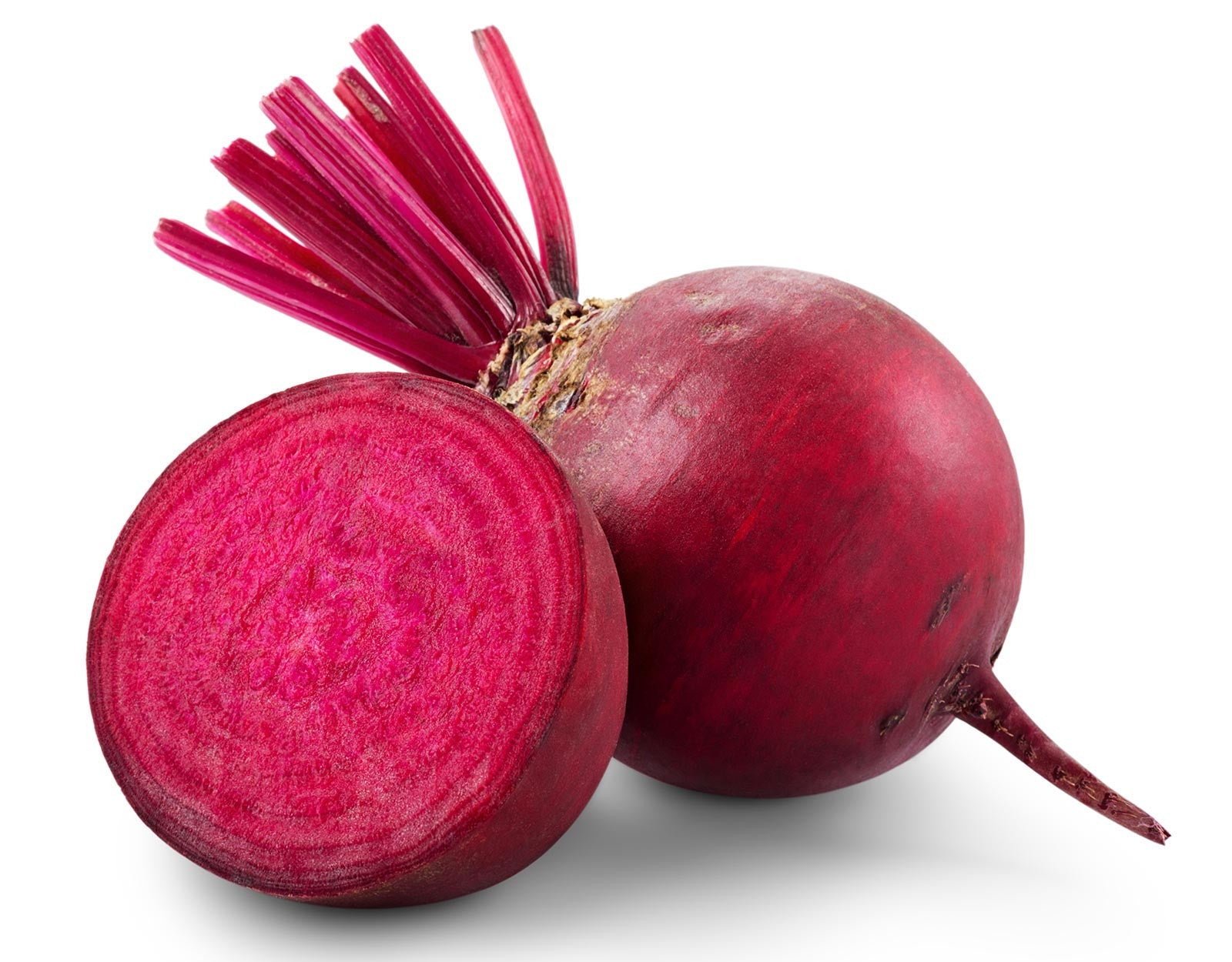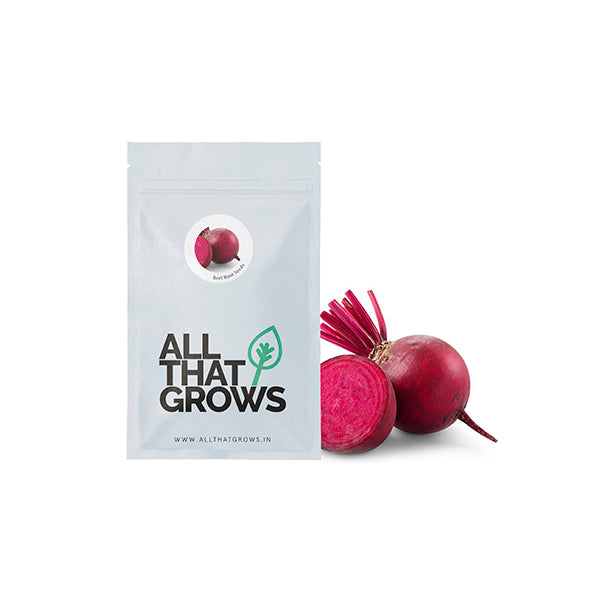



Beet Root Seeds
Grow this with
Seed Type: Non-Hybrid, Open Pollinated and Non-GMO
Root Shape: Uniform globe
Root Color: Pure deep red
Flesh Color: Dark red without stripes
Fruit Weight: 80 - 100 grams
Days to Maturity: 80 - 90 days after sowing
Specification: Sweet in taste, very juicy, non pungent.
- SOWING
TIMEAug - Oct
- Sowing
DistanceSeed to seed - 4"
Line to line - 18" - Fruit
Weight80-100 gms
- Fruit
ShapeUniform globe
- Days to
maturity80-90 days
- Details
- How to sow
- Reviews
Beetroot consists of the phytonutrient betalain responsible for making it an antioxidant, anti-inflammatory, and detoxifying in nature. And it is the plant pigment, betacyanin, responsible for the rich purplish-red tone. The presence of this pigment is what helps prevent the formation of some kinds of cancer cells in the body and prevents birth defects too. Consuming beetroot, better known as Chukandar in India, is very beneficial for the liver and the quickest way to recover from iron deficiency. While detoxifying, beetroot also helps keep the disorders of the liver at bay. Being rich in fibre, beetroot stimulates better bowel functions and stimulates an increase in the antioxidant enzymes. It also comprises glutamine, an essential amino acid that keeps the intestinal tract in good shape. Having a shot of beet juice daily has a positive effect on blood pressure levels too.
Mostly, beetroot is eaten raw in salads but it can also be mixed in juices and smoothies or even cooked and pickled.
Planting instructions
In zones with low moisture and rainfall, soak the seeds for 24 hours before implanting.
When the seedlings are about 2.5cm high, thin out to leave one seedling per 10cm station.
Plant seeds ½ inch deep and 1-2 inches apart.
Ensure that the soil remains moist for germination.
Growing Requirements
watering
Mulch and water well. Beets need to maintain plenty of moisture.
pests
Garden pests that attack the crop might cause the following symptoms -small, shiny specks, curled leaves, leaf deformities and a yellowish tint. The pests that might attack the crop maybe - Flea Beetles Leaf Hoppers Mexican Bean Beetle
soil
Beetroot likes neutral, moist, fertile soil without too much lime or acidity (pH 6.5-7.0). The soil should be neutral or slightly alkaline.
spot
Beetroot needs a sunny position but it can also thrive in shade
temperature
Ideal temperature would be between 7°C and 25°C (44-77 F)
how to harvest
Days to maturity vary between 50 and 70 for most varieties, although they can be harvested at any time you see fit. If you like larger bulbs, wait longer,although they will be tough and woody.
Do not let greens grow above 6 inches before harvesting.
Nipping off the tops of beets will keep them fresher for longer. Leave about one inch of stem on each beat, and store the greens separately.
Beets can be frozen, canned and pickled.

Customer Reviews
The productiveness of any seed we sell is subject to your local climatic conditions*, the sowing method you adopt, and your commitment to the planting process. We give no warranty, expressed or implied, and are in no way responsible for the produce.
Please note that all our seasonal recommendations/ sowing information is as per the local climatic conditions. *For more information on the optimum conditions required for growing seeds in your region, please contact us at, hello@allthatgrows.in or Whatsapp us at, +91 8544865077
Questions & Answers
Have a Question?
Be the first to ask a question about this.




Beet Root Seeds
Seed Type: Non-Hybrid, Open Pollinated and Non-GMO
Root Shape: Uniform globe
Root Color: Pure deep red
Flesh Color: Dark red without stripes
Fruit Weight: 80 - 100 grams
Days to Maturity: 80 - 90 days after sowing
Specification: Sweet in taste, very juicy, non pungent.
Grow this with
Beetroot consists of the phytonutrient betalain responsible for making it an antioxidant, anti-inflammatory, and detoxifying in nature. And it is the plant pigment, betacyanin, responsible for the rich purplish-red tone. The presence of this pigment is what helps prevent the formation of some kinds of cancer cells in the body and prevents birth defects too. Consuming beetroot, better known as Chukandar in India, is very beneficial for the liver and the quickest way to recover from iron deficiency. While detoxifying, beetroot also helps keep the disorders of the liver at bay. Being rich in fibre, beetroot stimulates better bowel functions and stimulates an increase in the antioxidant enzymes. It also comprises glutamine, an essential amino acid that keeps the intestinal tract in good shape. Having a shot of beet juice daily has a positive effect on blood pressure levels too.
Mostly, beetroot is eaten raw in salads but it can also be mixed in juices and smoothies or even cooked and pickled.
Seed Type: Non-Hybrid, Open Pollinated and Non-GMO
Root Shape: Uniform globe
Root Color: Pure deep red
Flesh Color: Dark red without stripes
Fruit Weight: 80 - 100 grams
Days to Maturity: 80 - 90 days after sowing
Specification: Sweet in taste, very juicy, non pungent.
- SOWING
TIMEAug - Oct
- Sowing
DistanceSeed to seed - 4"
Line to line - 18" - Fruit
Weight80-100 gms
- Fruit
ShapeUniform globe
- Days to
maturity80-90 days
Planting instructions
In zones with low moisture and rainfall, soak the seeds for 24 hours before implanting.
When the seedlings are about 2.5cm high, thin out to leave one seedling per 10cm station.
Plant seeds ½ inch deep and 1-2 inches apart.
Ensure that the soil remains moist for germination.
Growing Requirements
watering
Mulch and water well. Beets need to maintain plenty of moisture.
pests
Garden pests that attack the crop might cause the following symptoms -small, shiny specks, curled leaves, leaf deformities and a yellowish tint. The pests that might attack the crop maybe - Flea Beetles Leaf Hoppers Mexican Bean Beetle
soil
Beetroot likes neutral, moist, fertile soil without too much lime or acidity (pH 6.5-7.0). The soil should be neutral or slightly alkaline.
spot
Beetroot needs a sunny position but it can also thrive in shade
temperature
Ideal temperature would be between 7°C and 25°C (44-77 F)
how to harvest
Days to maturity vary between 50 and 70 for most varieties, although they can be harvested at any time you see fit. If you like larger bulbs, wait longer,although they will be tough and woody.
Do not let greens grow above 6 inches before harvesting.
Nipping off the tops of beets will keep them fresher for longer. Leave about one inch of stem on each beat, and store the greens separately.
Beets can be frozen, canned and pickled.



 Sign In
Sign In








